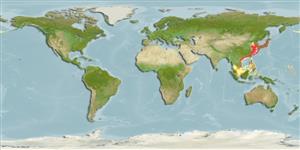Environment: milieu / climate zone / depth range / distribution range
Ecologia
marino demersale; distribuzione batimetrica 20 - 115 m (Ref. 11230). Temperate
Western Pacific: southern Japan and South China Sea.
Size / Peso / Age
Maturity: Lm ? range ? - ? cm
Max length : 40.0 cm SL maschio/sesso non determinato; (Ref. 559); Età massima riportata: 6 anni (Ref. 94118)
Inhabits sand and mud bottoms (Ref. 11230).
Life cycle and mating behavior
Maturità | Riproduzione | Deposizione | Uova | Fecundity | Larve
Masuda, H. and G.R. Allen, 1993. Meeresfische der Welt - Groß-Indopazifische Region. Tetra Verlag, Herrenteich, Melle. 528 p. (Ref. 9137)
IUCN Red List Status (Ref. 130435: Version 2024-1)
Threat to humans
Harmless
Human uses
Pesca: commerciale
Strumenti
Special reports
Download XML
Fonti Internet
Estimates based on models
Preferred temperature (Ref.
123201): 13 - 25.5, mean 21.9 °C (based on 111 cells).
Phylogenetic diversity index (Ref.
82804): PD
50 = 0.5000 [Uniqueness, from 0.5 = low to 2.0 = high].
Bayesian length-weight: a=0.00407 (0.00278 - 0.00597), b=3.11 (2.99 - 3.23), in cm total length, based on LWR estimates for this species & Genus-body shape (Ref.
93245).
Trophic level (Ref.
69278): 3.6 ±0.4 se; based on size and trophs of closest relatives
Resilienza (Ref.
120179): Medio, tempo minimo di raddoppiamento della popolazione 1.4 - 4.4 anni (K=1-1.16).
Fishing Vulnerability (Ref.
59153): Moderate vulnerability (41 of 100).
